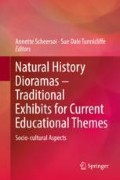Abstract
This chapter addresses the role of conflict in understanding dioramas containing cultural representations, especially models or re-creations of indigenous cultures and actual people created for natural history museums. We use three specific examples of such conflict: African-Americans, South African Bushmen and Native Americans. The three cultural conflict examples used here stem from dioramas or depictions that have already been contested, modified, and/or removed. These examples are taken from different peoples of various cultures, languages, and social systems, but who share the experience of having their cultural realities misrepresented.
Access this chapter
Tax calculation will be finalised at checkout
Purchases are for personal use only
References
Aikenhead, G., & Michell, H. (2011). Bridging cultures: Scientific and indigenous ways of knowing nature. Don Mills: Pierson.
Ash, D. (in preparation). Reculturing museums: equity in and outside museums. London: Routledge.
Brundage, W. F. (2003). Meta Warrick’s 1907 “negro tableaux” and (re)presenting African American historical memory. The Journal of American History, 89, 1368–1400.
Byrne, D. (2014). An unexpected history lesson at the Rijksmuseum. http://davidbyrne.com/journal/an-unexpected-history-lesson-at-the-rijksmuseum. Accessed 10 Dec 2017.
Capriccioso, R. (2009). Museum to remove controversial Native American dioramas. http://indiancountrytodaymedianetwork.com/2009/09/11/museum-remove-controversial-native-american-dioramas-83088. Accessed 8 Feb 2016.
Chinn, P. (2007). Decolonizing methodologies and indigenous knowledge: The role of culture, place and personal experience in professional development. Journal of Research in Science Teaching, 44(9), 1247–1268.
Coombes, A. (2003). History after apartheid: Visual culture and public memory in a democratic South Africa. Durham/London: Duke University Press.
Dartt-Newton, D. D. (2009). Negotiating the master narrative: Museums and the Indian/Californio Community of California’s Central Coast. http://hdl.handle.net/1794/9926. Accessed 4 Jan 2014.
Davison, P. (1993). Human subjects as museum objects: A project to make life– Casts of ‘bushman and hotentots’, 1907 to 1994. Annals of the South African Museum, 101, 165–183.
Davison, P. (2005). Redressing the past: Integrating social history collections at Iziko. South African Museums Association Bulletin, 1, 14.
Dawson, E. (2014). Equity in informal science education: Developing an access and equity framework for science museums and science centres. Studies in Science Education, 50(2), 209–247.
Diep, R. (2014). The passing of the Indians behind glass. The Appendix: Futures of the Past, 2(3). http://theappendix.net/issues/2014/7/the-passing-of-the-indians-behind-glass. Accessed 12 Feb 2016.
Dubin, S. C. (1992/2014). Displays of power: Controversy in the American, 2005n Museum from the Enola Gay to sensation! New York: New York University Press.
Dubin, S. C. (2006). Incivilities in civil(−ized) places: “Culture wars” in comparative perspective. In S. Macdonald (Ed.), A companion to museum studies. London: Blackwell Reference Online. https://doi.org/10.1111/b.9781405108393.2006.x.
Dubin, S. C. (2007). Transforming museums: Mounting Queen Victoria in a Democratic South Africa. New York: Palgrave Macmillan.
Dubin, S. C. (2010). Displays of power: Memory and amnesia in the American museum. New York: NYU Press.
Gordon, R. J. (1992). The bushman myth: The making of a Namibian underclass. Oxford: Westerville Press.
Gorski, P. C. (2010). Unlearning deficit ideology and the scornful gaze: Thoughts on authenticating the class discourse in education. Accessed 12 Feb 2015.
Gurian, E. H. (2006). Civilizing the museum: The collected writings of Elaine Heumann Gurian. London: Routledge.
Hadal, K. A. (2013). Why native American art doesn’t belong in the American Museum of Natural History. http://indiancountrytodaymedianetwork.com/2013/02/20/why-native-american-art-doesnt-belong-american-museum-natural-history-147792. Accessed 16 Feb 2016.
Hooper-Greenhill, E. (1992). Museums and the shaping of knowledge. London: Routledge.
Hooper-Greenhill, E. (1994). Museums and their visitors. London: Routledge.
Jackson, B. G., & Davis, D. W. (1908). The industrial history of the negro race of the United States. Richmond: Negro Educational Association.
Jackson, S., & Robbins, S. (1999). Miscast: The place of the museum in negotiating the Bushmen past and present. Critical Arts, 13(1), 69–101.
Kendi, I. X. (2016). Stamped from the beginning: The definitive history of racist ideas in America. New York: Nation Books.
Kutner, M. (2015). Museum dioramas are as endangered as the animals they contain? http://www.newsweek.com/2015/08/14/museum-dioramas-endangered-american-museums-358943.html. Accessed 27 Feb 2016.
Lonetree, A. (2009). Museums as sites of decolonization: Truth telling in national and tribal museums. In S. S. Smith (Ed.), Contesting knowledge: museums and indigenous perspectives (pp. 322–337). Lincoln: University of Nebraska Press.
Lonetree, A. (2012). Decolonizing museums: Representing native America in National and Tribal Museums. Chapel Hill: University of North Carolina Press.
Lonetree, A., & Cobb, A. J. (2008). The national museum of the American Indian: Critical conversations. Lincoln: University of Nebraska Press.
Macdonald, S. (2006). A companion to museum studies. London: Blackwell Reference.
Macleod, R. (1998). Post colonialism and museum knowledge: Revisiting the museums of the pacific. Pacific Science (52, 4) 308–318. University of Hawai’i Press.
McPhee, R. (2012). Natural history dioramas: Seeing through to the other side. The Blog, Huffington Post. http://www.huffingtonpost.com/ross-macphee/natural-history-dioramas-_b_1975451.html. Accessed 2 Feb 2016.
Miller, J. (2015). Native American dioramas at University of Michigan Exhibit Museum of Natural History to be removed. http://www.annarbor.com/news/native-american-dioramas-at-u-m-exhibit-museum-of-natural-history-to-be-removed-jan-4/the. Ann Arbor News. Accessed 27 Feb 2016.
Rankin, E., & Hamilton, C. (1999). Revision; reaction; re-vision: The role of museums in transforming South Africa. Museum Anthropology, 22(3), 3–13.
Stampp, K. (1956). The peculiar institution: Slavery in the ante-bellum South. Knopf New York: Vintage Books.
Thomas, N. (1993). Indigenous presences and national narratives in Australasian museums. Paper presented to Museums Australia, Communicating Cultures, Brisbane.
Thompson, K. S. (2005). Natural history museum collections in the 21st century. Action Bioscience. http://www.actionbioscience.org/evolution/thomson.html. Accessed 26 March 2016.
Tolbert, S. (2015). “Because they want to teach you about their culture ...”: Analyzing effective mentoring conversations between culturally responsible mentors and secondary science teachers of indigenous students. Journal of Research in Science Teaching, 52, 1325–1361. https://doi.org/10.1002/tea.21240.
Author information
Authors and Affiliations
Editor information
Editors and Affiliations
Rights and permissions
Copyright information
© 2019 Springer Nature Switzerland AG
About this chapter
Cite this chapter
Ash, D. (2019). Cultural Conflict: The Stories Dioramas Tell and Don’t Tell. In: Scheersoi, A., Tunnicliffe, S. (eds) Natural History Dioramas – Traditional Exhibits for Current Educational Themes. Springer, Cham. https://doi.org/10.1007/978-3-030-00208-4_8
Download citation
DOI: https://doi.org/10.1007/978-3-030-00208-4_8
Published:
Publisher Name: Springer, Cham
Print ISBN: 978-3-030-00207-7
Online ISBN: 978-3-030-00208-4
eBook Packages: EducationEducation (R0)

